
A blue screen of death error is one of the most irritating errors as it completely stalls your work. However, these errors are quite common and almost every Windows user has come across one.
That said, not all BSOD errors are difficult to resolve. A case in point is Critical Structure corruption, which is also known as STOP 0×00000109. While it is always irritating to receive an error while working on your desktop or laptop, this blue screen of death error can be resolved quite easily.
Let’s know more about this error in detail
What is Critical Structure Corruption BSOD?
The Critical Structure Corruption blue screen of death error appears randomly and the system freezes and you’ll have to reboot your computer. If you are working on something important when this BSOD appears, you are more likely to lose unsaved work.
Windows gives out “Critical Structure Corruption” error when it finds one of the file that it owns has been modified or the data in one of the file in the memory has been modified. There can be several causes of this error, such as corruption of system file, problems with hardware especially RAM, one of third party application or even malware infection.
Now that we know the causes, we can move ahead to the solution. Whenever Windows shows a Blue Screen of death on the screen, it creates a log file that has more information of the error. If you are tech-savvy, you can check the log file to get details of the causes of the BSOD and then pick the right solution.
If you are not tech-savvy, you can start with first solution and see if it helps. If it does not resolve issue, you need to move to next solution and so on.
How to check the log file to know more about “Critical Structure corruption” error?
The System Log in Event Viewer can give you additional information about the “Critical Structure corruption” error.
Here are the steps to follow:
- Press Windows logo key and R simultaneously on the keyboard to launch Run command console
- In the Run command box, type eventvwr and hit Enter on the keyboard
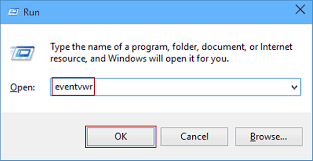
- Click Event Viewer
- Navigate to Windows Logs-> System
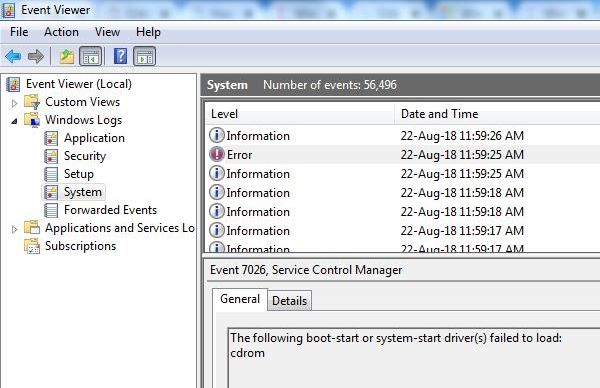
- In the right hand pane under System and in the column Level, look for error entries. (you can check the date and time of the error to determine the exact error entry for Critical Structure corruption BSOD)
- Click on the error to get more details
- Based on your findings, you can select the right solution given in this post
- If you don’t find anything in System log, start with Solution One.
Solution One – Perform a clean boot
A “clean boot” starts your computer with a minimal set of drivers and startup programs. It’s a good way to know whether other programs are causing Critical Structure corruption BSOD. Here are the steps to follow.
- Press Windows logo key and R simultaneously on the keyboard to bring up Run command console.
- In the Run command box, type msconfig and hit Enter on the keyboard
- In the System Configuration window, click Services tab
- tick the box Hide all Microsoft services
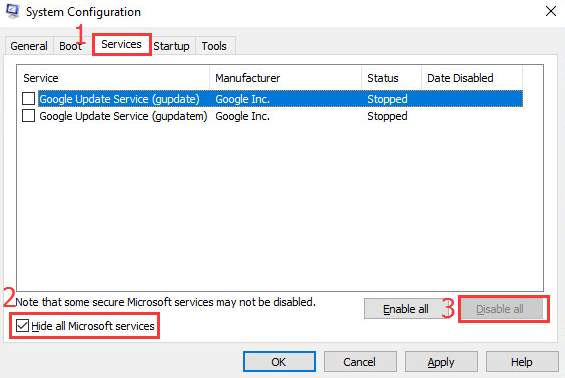
- Click Disable all
- Now go to Startup tab and click Open Task Manager
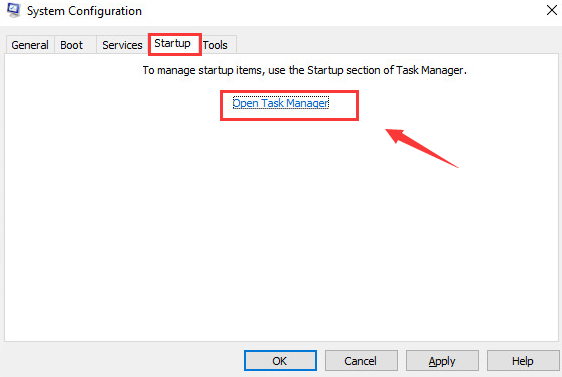
- In the Task Manager window, go to Startup tab
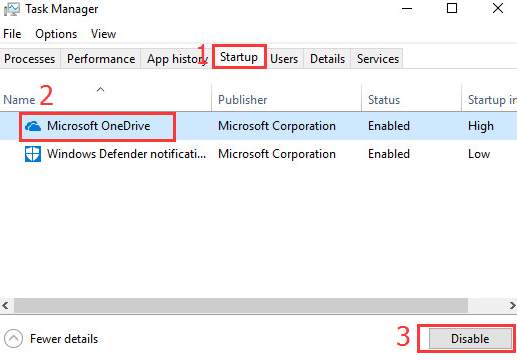
- Select the programs/services you see and disable them one by one
- Close Task Manager window
- Return to System configuration window and click OK
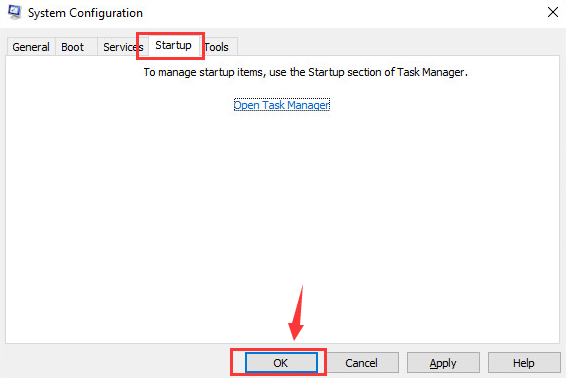
- Restart your computer
Now check whether you are getting Critical Structure corruption BSOD. If the error persists, move to next solution.
Solution Two – Uninstall problematic programs
Programs like Daemon Tools, Alcohol 120%, Intel HAXM (Hardware Accelerated Execution Manager), and MacDriver are known to cause BSOD errors like Critical Structure corruption. If you have any of these programs installed, we suggest you to either uninstall them or upgrade them to latest version.
After you have followed instructions above, check whether you still get Critical Structure corruption BSOD. if the problem persists, move to next solution.
Solution Three – Run SFC scan
One of the causes of Critical Structure corruption BSOD could be corruption of system files. A simple solution to resolve this issue is run SFC scan. Windows offers a System file checker tool that check the integrity of the system files and finds corrupted files. It also detects any missing files and replaces them with good cached versions. The SFC is a command line tool (No GUI) and you need to run it through command prompt with admin rights. Here are the steps to follow.
- Click Start
- Type cmd in the search box. Windows 10 users can type cmd in Cortana search box
- Right-click cmd from the list of search results and click Run as administrator
- In the command prompt window, type sfc /scannow and press Enter on keyword
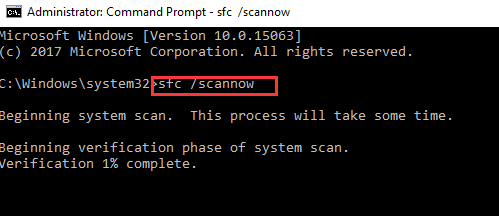
- The SFC scan process may take some time to complete. Wait for the command operation to complete and then close command prompt window
Try to use computer for some time and see if the Critical Structure corruption BSOD is generated. If the issue is not resolved, move to next solution.
Solution Four-Run DISM tool
In some cases, SFC is not able to replace corrupt files and the issues do not get resolved. In such scenarios, you need to use the DISM tool. DISM stands for Deployment Image Servicing and Management. DISM is command line utility that is used to repair Windows Recovery environment.
In this solution, we run DISM commands that use Windows update to provide files that are needed to fix file corruptions. Here are the steps you need to follow
- Open command prompt window with admin rights. You can refer to the steps given in Solution Three – Run SFC command to open an command prompt with admin rights
- In the command prompt window, type the following commands and hit Enter on the keyboard after each command.
- exe /Online /Cleanup-image /Scanhealth
- exe /Online /Cleanup-image /Restorehealth
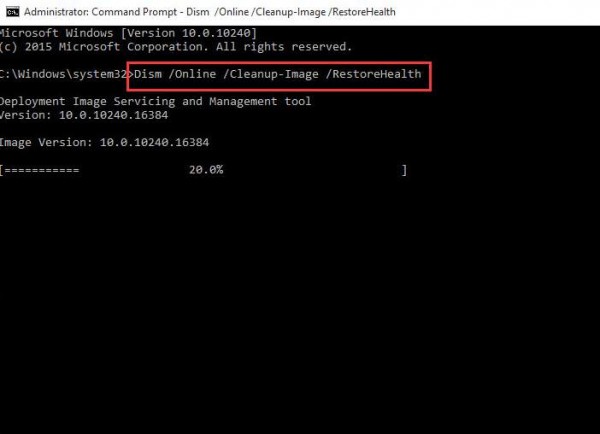
- Wait for some time as it may take several minutes for the command operation to complete
- When the command operation is completed, close command prompt window
- Reboot Windows
Solution Five- Check computer memory for any faults
A faulty RAM module can be one of the reasons behind Critical Structure corruption BSOD. If the memory module is faulty, it prevents Windows from accessing files stored in the memory that could lead to errors like Critical Structure corruption.
Windows features an in-built memory diagnostic tool that can check computer memory for any faults. Here are the steps you need to follow.
- Press Windows key and R button simultaneously on the keyboard to access Run command console
- In the Run command window, type exe
- You will get two options- 1) Restart now and check for problems (recommended) and 2) Check for problems the next time I start my computer.
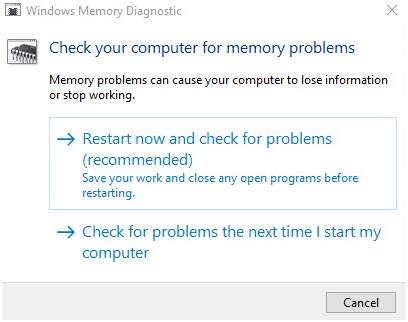
- If you want to immediately check memory, select Restart now and check for problems else select Check for problems the next time….
- If you have selected Restart now….., the computer will restart and you will see Windows Memory Diagnostic tool in action checking computer memory for any faults
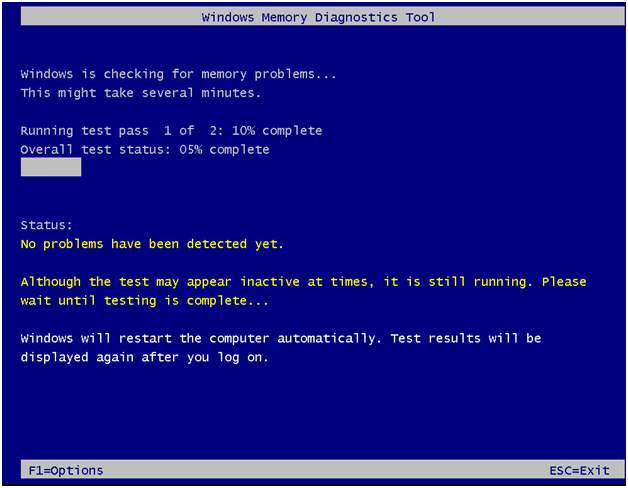
- If you select Check for problems the next time…… the Windows Memory Diagnostic tool would run when the computer reboots next time.
- If Windows Memory Diagnostic tool finds any problem with computer memory, it will report an error. In that case, you need to replace faulty RAM module.
- If the Windows Memory Diagnostic tool completes the process without reporting any error, you can draw a conclusion the computer memory is good and not the cause of Critical Structure corruption BSOD.
Start the PC and see if the issue is resolved. If the issue still persists, try next solution.
Solution Six – Update Drivers
Sometimes BSOD errors can occur because of outdated or corrupt drivers. To fix the issue, you would need to update your drivers. You can do the same using a reliable and easy-to-use driver software tool.
Automatic driver update tools offer many benefits, the most important ones being:
- You can update device drivers automatically
- The software scans and updates all outdated or missing drivers at one go
- The tool picks the right drivers for your device and operating system, so you won’t have to worry about installing an incorrect driver by mistake
- Automatic driver updates are 100% safe
Driver Updater is one of the best driver update tools out there. Outbyte Driver Updater will give you access to a database of over 1 million drivers. It will regularly scan your PC, suggesting new driver versions to install. Driver Updater contains drivers for a variety of Windows devices. With just one click, you can update drivers in your system.
Step 1
Click here to Install and launch the app
Step 2
Scan all devices
Step 3
Install or update drivers automatically
Last Resort
If none of the above solutions have worked for you, the last solution to resolve the Critical Structure corruption BSOD is reinstalling Windows.

Leave a Reply